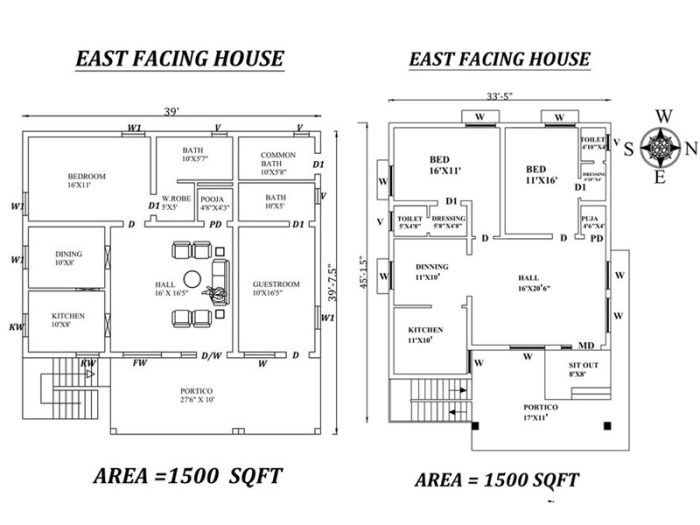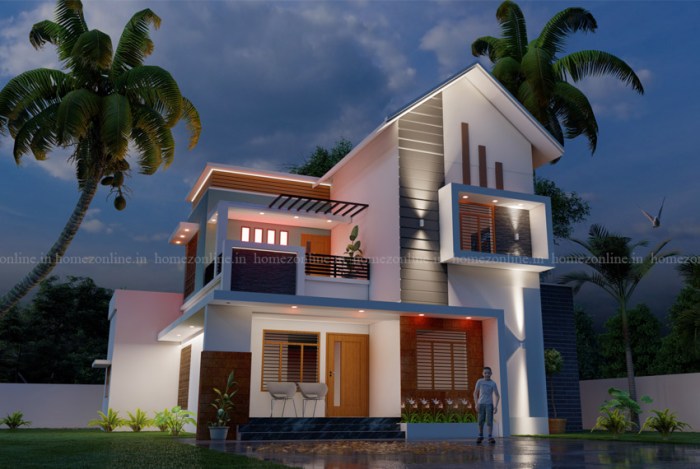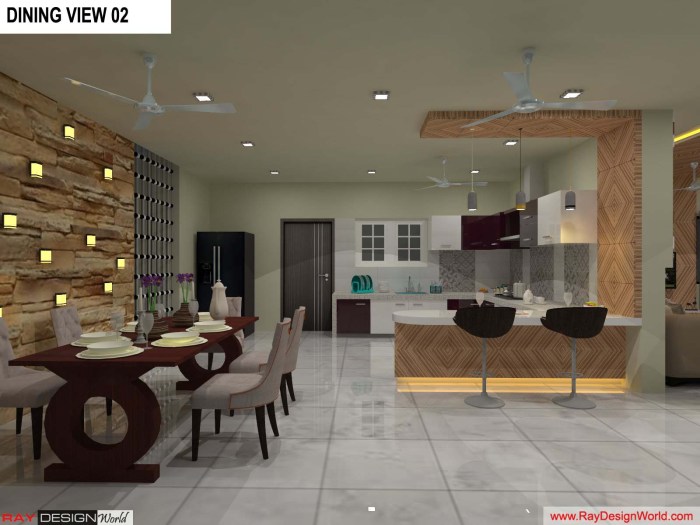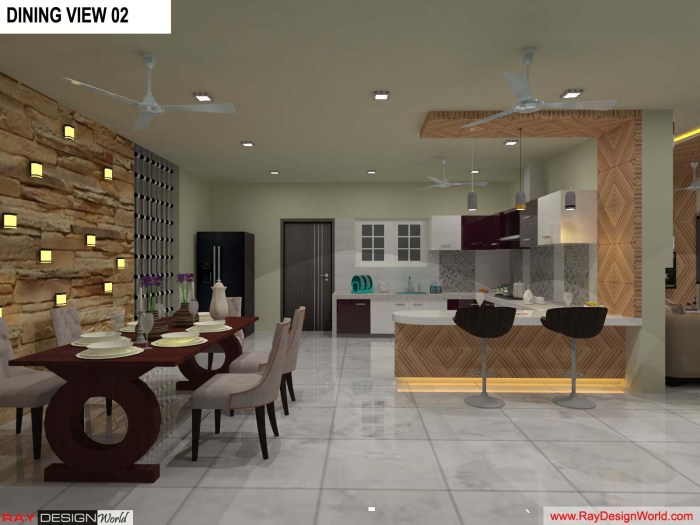1500 sq ft house interior design sets the stage for creating comfortable and stylish living spaces. This square footage offers a balance of room for functionality and design flexibility. Whether you’re a homeowner seeking to renovate or a designer tackling a new project, understanding the unique opportunities and challenges of a 1500 sq ft house is key to maximizing its potential.
This guide delves into the essential aspects of interior design for a 1500 sq ft house, from defining your style and maximizing functionality to selecting furniture, lighting, and incorporating sustainable practices. We’ll explore popular design styles, offer tips for creating focal points, and provide insights into kitchen, bathroom, and bedroom design.
By the end, you’ll have a comprehensive understanding of how to transform your 1500 sq ft house into a beautiful and inviting home.
Maximizing Functionality
A 1500 sq ft house offers ample space for creating a comfortable and functional living environment. By implementing smart design strategies, you can maximize the use of every square foot while ensuring a seamless flow and efficient use of space.
Designing a 1500 sq ft house can be a fun challenge, balancing functionality with aesthetics. While it offers more space than a 1000 sq ft house interior design , it still requires smart planning. Open floor plans, clever storage solutions, and maximizing natural light are all crucial aspects of a successful 1500 sq ft home design.
Maximizing Storage Space
Effective storage solutions are crucial for maintaining a clutter-free and organized home.
- Built-in Storage:Consider incorporating built-in storage solutions like cabinets, shelves, and drawers into your design. These custom-made units can maximize vertical space and utilize often-wasted areas, such as under stairs or in alcoves. For example, a built-in pantry in the kitchen can efficiently store groceries and cooking supplies, while a custom-designed closet in the bedroom can organize clothing and accessories.
- Multi-Functional Furniture:Opt for furniture that serves multiple purposes, such as a sofa bed in the living room or a coffee table with built-in storage. This helps to conserve space while adding versatility to the room.
- Vertical Storage:Utilize vertical space by incorporating tall bookshelves, wall-mounted organizers, and hanging storage solutions. This maximizes storage capacity without taking up valuable floor space.
Natural Light and Ventilation
Natural light and ventilation are essential for creating a healthy and inviting living environment.
- Maximize Natural Light:Use large windows to flood the house with natural light. Consider skylights for additional light in areas that lack natural light. Position furniture strategically to maximize natural light and create a bright and airy ambiance.
- Proper Ventilation:Ensure adequate ventilation throughout the house by incorporating windows and doors that can be opened for fresh air circulation. Install exhaust fans in bathrooms and kitchens to remove moisture and odors. This helps to create a comfortable and healthy indoor environment.
Creating a Focal Point

In a 1500 sq ft house, strategically placed focal points can draw the eye, enhance the flow of the space, and create a sense of visual interest. Focal points can be achieved through furniture placement, lighting, artwork, and statement walls, adding depth and character to your home.
Using Furniture and Lighting
Furniture arrangement plays a significant role in establishing focal points. Placing a large sofa or a statement armchair opposite a fireplace or a captivating window can instantly create a visual anchor. Lighting further emphasizes these focal points. A well-placed chandelier over a dining table, a dramatic floor lamp beside a reading nook, or strategically placed accent lighting around artwork can highlight specific areas, drawing attention and enhancing the overall ambiance.
Utilizing Artwork and Statement Walls
Artwork, such as a large painting, a gallery wall, or a unique sculpture, can serve as a captivating focal point. These pieces can add a touch of personality and create a visual dialogue within the space. A statement wall, painted in a bold color or featuring a unique wallpaper design, can serve as a dramatic backdrop, enhancing the overall aesthetic and providing a visual anchor for the room.
Creating a Statement Wall
Here are some ideas for creating a statement wall in your 1500 sq ft house:
- Bold Color:A vibrant hue like emerald green, deep navy, or terracotta can add a dramatic touch to a living room or bedroom.
- Textured Wallpaper:Embossed wallpaper with intricate patterns or geometric designs can create a sophisticated and visually engaging focal point.
- Wood Paneling:Natural wood paneling can add warmth and texture to a room, creating a visually striking statement wall.
- Built-in Shelving:Custom-built shelving units can be a practical and stylish way to create a focal point while offering additional storage space.
- Architectural Features:Highlight existing architectural features like a fireplace mantel or a bay window by painting them a contrasting color or adding decorative molding.
Furniture Selection

In a 1500 sq ft house, furniture selection plays a crucial role in defining the overall aesthetic and functionality of the space. Choosing the right furniture size and scale is paramount to creating a balanced and inviting atmosphere.
Furniture Size and Scale
Selecting furniture that complements the dimensions of your 1500 sq ft house is essential. Oversized furniture can make a space feel cramped, while undersized furniture can appear lost and insignificant.
Designing a 1500 sq ft house can be a fun challenge, allowing for creative freedom with space. If you’re looking for inspiration for a smaller home, you might find helpful ideas in the realm of 10 marla house interior design , which often involves maximizing functionality in limited space.
These designs can offer valuable insights for optimizing layout and incorporating clever storage solutions, which can be equally relevant to a 1500 sq ft house, especially if you want to make the most of every inch.
- Measure your space accurately:Before purchasing any furniture, measure the length, width, and height of each room. This will help you determine the maximum size of furniture that can comfortably fit in the space.
- Consider the scale of your furniture:A large sofa might be ideal for a spacious living room, but it could overwhelm a smaller family room. Pay attention to the overall scale of your furniture and how it relates to the size of your rooms.
- Think about traffic flow:Ensure that furniture is placed in a way that allows for easy movement throughout the house. Leave enough space between furniture pieces for comfortable passage.
Maximizing Comfort and Functionality
Beyond size and scale, furniture selection should prioritize comfort and functionality. Here are some guidelines for choosing furniture that meets these needs:
- Choose comfortable seating:Invest in sofas, chairs, and ottomans that provide adequate support and cushioning. Consider the density and firmness of the upholstery when making your selection.
- Select furniture with storage:Storage furniture, such as ottomans with hidden compartments or beds with built-in drawers, can help maximize space and keep your home organized.
- Opt for multi-functional pieces:Consider furniture that serves multiple purposes, such as a sofa bed or a coffee table that doubles as a dining table.
Furniture Arrangements for a Balanced and Inviting Atmosphere
Furniture arrangement plays a significant role in creating a balanced and inviting atmosphere. Here are some examples of furniture arrangements that promote a welcoming ambiance:
- Living Room:A classic arrangement for a living room involves placing a sofa facing a coffee table with chairs or armchairs flanking the sofa. This creates a conversational area where people can gather comfortably.
- Dining Room:For a dining room, a rectangular table with chairs placed evenly around it is a common and practical arrangement. Consider a round table if you have a smaller space, as it promotes a more intimate and casual dining experience.
- Bedroom:In a bedroom, a bed placed against a wall with nightstands on either side is a traditional and comfortable layout. Add a dresser and a chair for additional functionality and visual appeal.
Lighting and Decor

Lighting is a crucial element in interior design, playing a significant role in shaping the ambiance and functionality of a space. A well-designed lighting plan can enhance the beauty of your home, highlight architectural features, and create a welcoming atmosphere for both residents and guests.
Designing a 1500 sq ft house interior can be a rewarding challenge. You’ll need to carefully consider the layout and flow to create a space that feels both spacious and inviting. If you’re looking for ideas for a single-story home, you might find inspiration in the 1 floor house interior design trends.
These designs often prioritize open floor plans and maximize natural light, which can be easily adapted to a 1500 sq ft space. Whether you choose a modern or traditional style, remember that functionality and aesthetics should go hand-in-hand.
This section explores the integration of natural and artificial light sources, discusses the impact of lighting on mood and ambiance, and provides examples of decorative elements that can elevate the overall design.
Lighting Plan
A comprehensive lighting plan for a 1500 sq ft house should consider a balance of natural and artificial light sources, catering to different functional areas and desired moods.
- Natural Light:Maximize natural light by strategically placing windows and skylights. Large windows in living areas and bedrooms can create a bright and airy feel, while strategically placed skylights in hallways and bathrooms can illuminate often-dark areas.
- Artificial Light:Artificial lighting provides flexibility and control, allowing you to create different moods and highlight specific features.
Here are some examples of artificial light sources that can be incorporated into a lighting plan:
- Ambient Lighting:Provides general illumination for the entire space. Examples include ceiling lights, chandeliers, and recessed lights.
- Task Lighting:Provides focused illumination for specific activities, such as reading, working, or cooking. Examples include desk lamps, under-cabinet lighting, and pendant lights over kitchen islands.
- Accent Lighting:Highlights architectural features, artwork, or decorative elements. Examples include track lighting, wall sconces, and spotlights.
Lighting and Mood
Lighting has a profound impact on mood and ambiance, influencing the overall feel of a space. Different types of lighting can evoke distinct emotions and create specific atmospheres.
- Warm White Lighting:Creates a cozy and inviting atmosphere, often used in living rooms, bedrooms, and dining areas.
- Cool White Lighting:Provides a crisp and clean feel, ideal for kitchens, bathrooms, and workspaces.
- Dimmable Lighting:Allows for flexibility in adjusting the brightness level, creating a range of moods from bright and energetic to soft and romantic.
Decorative Elements, 1500 sq ft house interior design
Decorative elements can enhance the overall design and create visual interest. Here are some examples of decorative elements that can be incorporated into a 1500 sq ft house:
- Artwork:Paintings, photographs, and sculptures can add personality and visual appeal to walls. Consider incorporating artwork that complements the overall design theme and reflects your personal style.
- Mirrors:Mirrors can create the illusion of space and reflect light, making rooms appear brighter and larger. Strategically placed mirrors can also enhance the beauty of existing features, such as a fireplace or a stunning view.
- Plants:Indoor plants bring life and freshness to a space. They can purify the air, add color and texture, and create a sense of tranquility. Choose plants that thrive in your home’s environment and complement the overall design.
- Rugs:Rugs can define areas, add warmth and comfort, and create a sense of visual interest. Consider using rugs in different textures, patterns, and colors to add depth and dimension to the space.
- Throws and Pillows:Soft throws and decorative pillows can add texture, color, and comfort to furniture. Choose throws and pillows that complement the overall design theme and create a welcoming atmosphere.
Color and Texture
Color and texture are essential elements in interior design, working together to create a cohesive and stylish space. They play a crucial role in shaping the mood and ambiance of a room, influencing how we perceive its size and functionality.
Color and Its Impact
Color selection is a critical aspect of interior design, impacting the overall atmosphere and perception of space. Color can evoke various emotions, from feelings of calmness and serenity to excitement and energy.
- Warm Colors:Warm colors like red, orange, and yellow are associated with energy, enthusiasm, and warmth. They can make a space feel more inviting and lively. For example, a bright orange accent wall in a living room can create a vibrant and welcoming atmosphere.
- Cool Colors:Cool colors such as blue, green, and purple are often linked to feelings of calmness, tranquility, and relaxation. They can make a space feel larger and more serene. For instance, a light blue bedroom can promote a peaceful and restful environment.
- Neutral Colors:Neutral colors like white, gray, and beige provide a blank canvas for other elements in the room. They create a sense of balance and allow for flexibility in decorating. Neutral colors can be used to create a sense of spaciousness, especially in smaller rooms.
Texture and Depth
Texture adds depth and interest to a room, enhancing the visual appeal and tactile experience. Different textures can be used to create a variety of moods and effects.
- Smooth Textures:Smooth textures, such as silk, satin, and polished wood, create a sense of elegance and sophistication. They can reflect light, making a space feel brighter and more spacious.
- Rough Textures:Rough textures, such as linen, burlap, and stone, add a sense of warmth, rusticity, and comfort. They can create a cozy and inviting atmosphere.
- Textural Contrast:Combining different textures can create visual interest and depth. For example, a smooth leather sofa paired with a rough woven rug can create a dynamic and stylish look.
Kitchen Design: 1500 Sq Ft House Interior Design
The kitchen is the heart of any home, a space for culinary creativity, social gatherings, and everyday life. In a 1500 sq ft house, the kitchen design should strike a balance between functionality and style, maximizing efficiency while creating a welcoming and aesthetically pleasing environment.
Kitchen Layout
The layout of a kitchen significantly impacts its functionality. A well-planned layout ensures easy movement, efficient workflow, and ample storage. Here’s a sample kitchen layout for a 1500 sq ft house, considering the placement of appliances, cabinets, and countertops:
| Area | Appliances | Cabinets | Countertops |
|---|---|---|---|
| Cooking Zone | Range, Oven, Microwave | Wall cabinets, Base cabinets | Granite or Quartz |
| Preparation Zone | Sink, Dishwasher | Base cabinets, Drawers | Stainless steel or Butcher Block |
| Storage Zone | Refrigerator, Pantry | Wall cabinets, Tall cabinets | Laminate or Tile |
Kitchen Design Elements
Several design elements contribute to a kitchen’s functionality and aesthetics:
- Work Triangle:The work triangle is a fundamental principle in kitchen design. It refers to the imaginary triangle formed by the refrigerator, sink, and range/cooktop. An ideal work triangle has a perimeter between 13 and 26 feet, allowing for efficient movement and workflow.
- Storage Solutions:Maximize storage with pull-out drawers, spice racks, corner cabinets, and under-sink organizers. Vertical storage solutions like tall cabinets or open shelving are great for maximizing space in smaller kitchens.
- Countertop Material:Durable and easy-to-clean countertops are essential. Popular options include granite, quartz, stainless steel, and butcher block. The choice depends on your budget, style, and desired level of maintenance.
- Backsplash:A backsplash protects the wall behind the countertops and adds a decorative element. Materials like tile, stone, glass, and metal offer a wide range of styles and textures.
- Lighting:Adequate lighting is crucial for a functional kitchen. Combine ambient lighting with task lighting, such as under-cabinet lights, to illuminate specific work areas.
Kitchen Design Examples
- Open Kitchen:An open kitchen connects to the living or dining area, creating a spacious and inviting atmosphere. This layout is popular in modern homes, fostering social interaction and a sense of openness.
- Island Kitchen:An island kitchen features a central island that serves as a gathering spot, extra counter space, and sometimes a breakfast bar. Islands can be customized with storage, seating, and even a sink or cooktop.
- Galley Kitchen:A galley kitchen is a linear design with parallel countertops and cabinets along two walls. This layout is efficient for smaller spaces and maximizes counter and storage space.
Bathroom Design
A well-designed bathroom can be a sanctuary in your 1500 sq ft home, offering a space for relaxation and rejuvenation. The key is to create a balance between functionality and aesthetics, ensuring that the space is both practical and inviting.
Bathroom Layout Design
A thoughtful layout is essential for maximizing functionality and creating a visually appealing space. Consider the following elements when designing your bathroom layout:
- Placement of Fixtures:The location of the toilet, shower, sink, and bathtub (if included) should allow for comfortable movement and prevent any potential conflicts. For example, placing the toilet and shower too close together can create a cramped feeling.
- Storage Solutions:A well-organized bathroom is a peaceful bathroom. Incorporate ample storage options, such as cabinets, drawers, shelves, and medicine cabinets. Utilize vertical space with tall cabinets and consider incorporating a linen closet if space allows.
- Decorative Elements:Add personality to your bathroom with decorative elements such as mirrors, artwork, plants, and stylish towels. Choose pieces that complement the overall design aesthetic and create a calming ambiance.
Importance of Natural Light and Ventilation
Natural light and ventilation are crucial for creating a healthy and comfortable bathroom environment.
- Natural Light:Maximize natural light by incorporating large windows or skylights. Natural light brightens the space, reduces the need for artificial lighting, and creates a more welcoming atmosphere.
- Ventilation:Proper ventilation is essential for removing moisture and odors, preventing mold growth, and maintaining a healthy environment. Install an exhaust fan that vents to the exterior, and consider opening windows for cross-ventilation when possible.
Bedroom Design
The bedroom is a sanctuary, a place to unwind and recharge after a long day. Designing a bedroom for a 1500 sq ft house allows for a comfortable and inviting space that reflects your personal style.
Choosing the Right Bed Size
The bed is the focal point of the bedroom, and its size plays a significant role in the overall feel of the space. For a 1500 sq ft house, a queen-sized bed is generally a good choice. It offers ample space for a comfortable sleep without overwhelming the room.
If you have a larger bedroom or prefer more space, a king-sized bed might be a better option. However, a full-sized bed can be a good option for smaller bedrooms or those who prioritize space.
Ultimate Conclusion
Designing a 1500 sq ft house involves a blend of creativity, functionality, and attention to detail. By understanding the principles of space planning, style selection, and maximizing natural light, you can create a home that reflects your personal taste while meeting the needs of your lifestyle.
Remember, the journey of interior design is a personal one, so embrace your own style and let your imagination guide you in transforming your 1500 sq ft house into a sanctuary you’ll love for years to come.
Essential FAQs
What are some common challenges of designing a 1500 sq ft house?
Balancing functionality with aesthetics in a smaller space can be a challenge. You may need to find creative storage solutions and prioritize multi-purpose furniture.
How do I choose the right interior design style for a 1500 sq ft house?
Consider your personal preferences, lifestyle, and the overall architecture of your house. Research different styles to find one that resonates with you.
What are some tips for maximizing natural light in a 1500 sq ft house?
Use light-colored paint, strategically place mirrors, and incorporate large windows. Minimize heavy curtains and consider skylights if possible.
Is it possible to make a 1500 sq ft house feel larger?
Absolutely! Use light colors, choose furniture with clean lines, and incorporate mirrors to create the illusion of more space.
